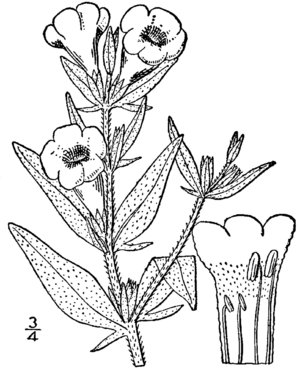Agalinis auriculata facts for kids
Quick facts for kids Agalinis auriculata |
|
|---|---|
 |
|
| Botanical illustration | |
| Conservation status | |
| Scientific classification | |
| Genus: |
Agalinis
|
| Species: |
auriculata
|
Agalinis auriculata is a special kind of flowering plant often called earleaf false foxglove. It belongs to the Orobanchaceae family. This plant is found only in the United States. You can find it from New Jersey all the way west to Minnesota, and also across many southern states.
Contents
What is Earleaf False Foxglove?
This plant is a hairy annual herb. This means it's a plant that grows from a seed, blooms, and dies within one year, and it has tiny hairs on its stem. Its stiff stem can grow up to about 90 centimeters (about 3 feet) tall.
The leaves grow in pairs opposite each other on the stem. They have special ear-shaped parts called "auricles," which is why it's called "earleaf." The stem itself has hairs that point downwards.
Its Unique Flowers
The flowers of the earleaf false foxglove are a beautiful purple color. Each flower has five main parts, or "lobes." Two of these lobes are smaller and more joined together at the top. The three lower lobes are larger and more separate.
If you look closely inside the purple flowers, you'll see purple spots in their throats. These plants usually bloom during the summer months, from July to September.
How it Gets Nutrients
This plant is quite interesting because it is hemiparasitic. This means it can make its own food using chlorophyll and sunlight, just like most plants. However, it also gets some of its nutrients by connecting to other plants. It's like a plant that can cook its own meals but also likes to borrow ingredients from its neighbors!
Scientists have seen this plant connect to and get nutrients from plants like Helianthus occidentalis (western sunflower) and Rudbeckia fulgida (showy black-eyed Susan) when grown in special gardens. In nature, it has also been seen connected to grasses, possibly Poa compressa (Kentucky bluegrass).
Where Does Earleaf False Foxglove Grow?
The earleaf false foxglove used to be much more common across the United States than it is today. It grows in many different areas.
Why Soil Disturbance is Important
This plant seems to need the soil to be disturbed for its seeds to sprout. In the past, large herds of bison might have helped by trampling the ground. Today, the plant can grow well in mounds of earth that have been dug up by animals like pocket gophers (Geomys bursarius).
Current Locations
Today, there are about 40 to 50 known places where this plant grows. Most of these groups of plants are quite small. The largest populations are found in Arkansas, Missouri, and Mississippi.
In Minnesota, the earleaf false foxglove is considered an endangered species. Old records show it used to grow in wet meadows along the lower Mississippi River valley. However, much of its natural home has been lost, especially around the Twin Cities area.
See Also


